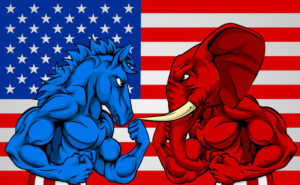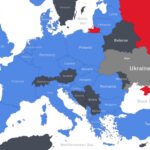Yes, politics is mean and nasty today. But arguably it’s been worse—there haven’t been any canings on the floor of the Senate recently (though I might entertain the argument that there should have been).
But politics is at a mean and dirty level we haven’t seen since the 1960s. Big government means more of everything is at stake in an election, and government today is far bigger than it’s ever been in the past, seeking to control more aspects of our life than ever before. That raises the stakes. Then there’s the factor of ideological polarization along party lines. That increases the all-or-nothing stakes in an election, and the Gallup Poll—which reports regularly on polarization—said this month that their poll “shows the highest party polarization on record.”
Gallup also finds that just 1% of Americans have no opinion on President Trump. That 1% must have no TV, radio, or Internet connection, as the Pew Research Center finds that media polarization is also at highest-ever levels. Lucky 1%, I’m tempted to say at times.
Is there hope for a more civil tomorrow?
In a word, no. And I hasten to repeat the plea, “don’t shoot the messenger.”
The main reason is that the action in the Democratic Party today is further to the Left than it’s ever been. And they are zealots who do not feel bound to observe the usual political niceties. There’s the violence and intimidation that takes place every day against Trump supporters (and that rarely gets reported in the “mainstream” media). But beyond that, there’s the conviction among virtually all Democrats that they don’t have to wait until the next election to set things right—take action today. That explains the partisan impeachment farce of the past three or more years.
Right now there’s a vicious fight brewing between the party’s “progressive” wing and its establishment wing—as an outsider, I’m looking forward to that one. But once the 2020 elections are over, both wings of the Democratic Party will be united in a concerted effort to demolish the structures they blame for giving Republicans their victories.
These structures are the last remaining vestiges that defined the United States as a republic of limited and divided powers. That includes the structure of the Senate (two senators per state, giving Wyoming equal representation with California or New York; plus the filibuster). But the main target, of course, is the Electoral College. Twice in this century (2000 and 2016) the Democrats have won the popular vote while the Republicans were victorious in the Electoral College, so the Electoral College is targeted for obliteration. The goal is to turn the United States into a complete mobocracy—the euphemism, of course, is “democracy.”
What are the odds for the Electoral College’s survival?

Source: Wikipedia
Republicans and conservatives won’t give in without a fight. They have been emboldened by a President who fights back, and fights to win. Heck, even Mitch McConnell was transformed by President Trump during the impeachment farce from the punk who gets sand kicked in his face by a beach bully, to a new Charles Atlas muscle-man. (You younger folks can substitute Arnold Schwarzenegger for Charles Atlas.)
A frontal assault on the Electoral College would also require a constitutional amendment, a long and cumbersome process. The Democrats don’t have the patience for that. They are nothing if not devious, and they have devised a side run that can achieve their aim. It’s called the National Popular Vote Interstate Compact. Conservatives and Republicans are just now becoming aware of this threat, but this will be a major battle after the elections, no matter which side prevails on November 3. And that’s why our politics will only become more mean and nasty next year and until the Democrats are totally victorious or defeated on this issue.
What Is the National Popular Vote Interstate Compact?
The compact is an agreement among states and the District of Columbia that they will award all their electoral votes to the presidential candidate that wins the popular vote nationwide. It goes into effect once the compact is signed by enough states to account for a majority of the Electoral College—270 votes.
Already the compact has been signed by 15 states and the District of Columbia that account for 196 electoral votes, or 72.6% of the total needed for implementation. That’s perilously close, and the legislation is pending in another 14 states that account for 171 electoral votes—more than enough for victory. And one of those 14 states is Virginia, now under Democrat control. The Virginia House has passed the compact legislation, the Virginia Senate has a 21-19 Democrat majority, and Democratic Governor “Blackface” Northam would be sure to sign it into law. The addition of Virginia, with its 13 electoral votes, would give the compact 209 votes, or 77% of the votes needed to abolish the impact of the Electoral College.
Conservatives, libertarians, and Republicans need to be awakened to the danger represented by the National Popular Vote Interstate Compact. Philosophical and constitutional arguments are a hard sell in the general electorate (“democracy” is such a nice-sounding word, and more people probably think the Constitution established the U.S. as a democracy rather than a republic). I suggest an emphasis instead on “practical” arguments against the compact.
Start by pointing out that only three of the 15 states endorsing the compact are in the Heartland—Illinois, Colorado, and New Mexico. The other 12 are on the East and West coasts. There’s a reason for this: The compact would give the two populous coasts veto power over who becomes President. Indeed, a presidential candidate wouldn’t have to campaign in the Heartland at all. (Well, maybe stops in Chicago and personal appeals to oligarchs in Aspen and Austin.) Also, under the compact a state could find its electoral votes going to a candidate who didn’t get a majority in the state. I don’t think these are conditions that would appeal to legislatures in the Heartland—certainly not if their electorates are aroused.
Remember Phyllis Schlafly!
All is not lost. In the 1970s the proposed Equal Rights Amendment (ERA) to the Constitution was further along the path to victory than today’s compact. It had passed the House by the lopsided vote of 354 to 23, and the Senate by an 84 to 8 vote. Such conservative stalwarts as Strom Thurmond and Spiro Agnew had voted for it—after all, what politician, mindful that half of his electorate consisted of women, would not vote for their “equality of rights under the law” (the innocuous language in the amendment). After that, 30 states had ratified the amendment in the first year after it passed in Congress, and only 8 more states were needed. The Equal Rights Amendment clearly was unstoppable.
Until an Alton, Illinois, housewife got into the picture, that is.
Phyllis Schlafly (one of my authors, on other book topics) joined the fight against ERA, pointing out the hidden dangers in the innocuous-sounding language. Before she was through, this fighting housewife (and the legions of women she led) had defeated the amendment. You can get the full details of how she did this starting on page 137 of the 2004 book by Richard Viguerie and yours truly, America’s Right Turn: How Conservatives Used New and Alternative Media to Take Power.
So it can be done. “Democracy” sounds as nice as “equal rights,” but it just takes a fighting spirit and determination to let the American people see the power-hungry leftist shenanigans behind the innocuous prose. To the battle!






